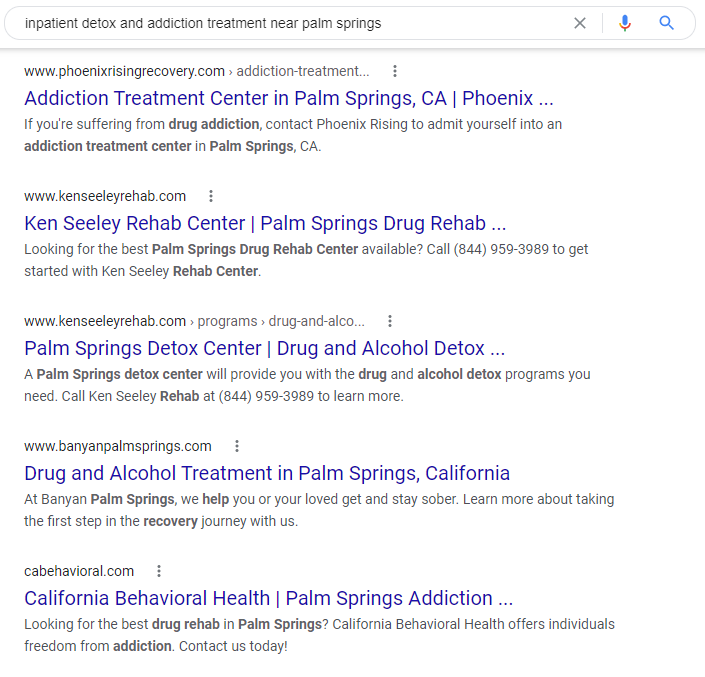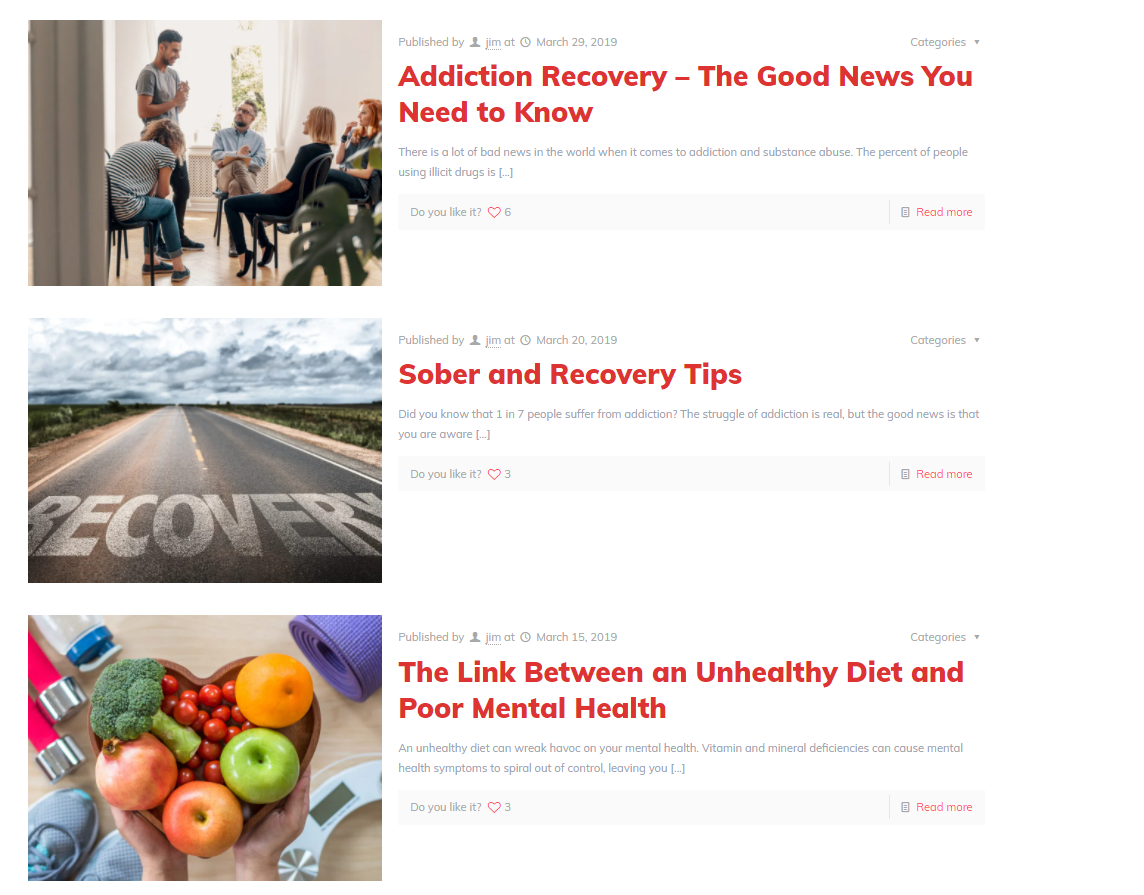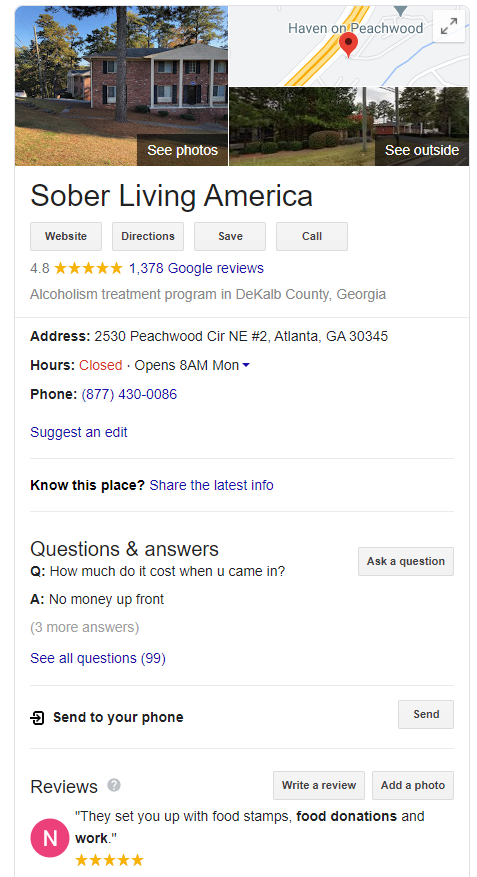At first glance, marketing and addiction treatment centers might seem like strange bedfellows. A closer look at how people struggling with addiction seek help, however, reveals that marketing—and search engine optimization (SEO), more specifically—makes a lot of sense.
The decision to seek help for addiction is highly personal. It’s a rather vulnerable place to be. Shame, fear, and uncertainty often prevent people from seeking help through their employers, family members, and friends. Instead, many people begin the journey with a Google search—an easy, anonymous way to test the water, ask questions, and see how rehab works.

It’s also a prime opportunity for addiction centers to rank authoritative, locally optimized content for the questions that people are asking about addiction. What follows is our introduction to SEO for addiction centers—a beginner’s guide, of sorts. This six-part SEO strategy is designed to help addiction centers increase online visibility, get “found” for target keywords, and persuade people to get help.
1. Develop your keyword strategy
First, let’s establish a little groundwork. When we talk about keywords, what we’re really talking about is language. We’re talking about the words people use to find information online about addiction treatment programs or look for rehab centers in your area. It’s this very language that search engines use to connect people with authoritative websites and content about addiction.
At its core, your keyword strategy is a specific list of keywords that you want to rank for, monitor, and measure performance against. It ought to be formalized, regularly updated, and far more developed than simply, “I want to rank for addiction centers in San Diego.”
Generally, your locally focused keyword strategy will break down into three parts:
- Establish goals for your keyword strategy. Do you want to increase organic traffic for a specific service, such as “alcohol and drug addiction rehab”? Grow a specific location? Outrank an emerging competitor?
- Research the way your ideal client searches. Learn how the kind of people who find their way into your programs search for information online. What questions do they ask? What do they call the services they’re looking for? Remember: it’s not always aligned with what you may call something internally.
- Build a formalized keyword strategy that’s aligned with the patient journey. As your ideal client persona moves through the process of finding a rehab center, what information are they looking for and what search terms do they use? This should be a living breathing document that’s updated regularly and shared with stakeholders.
SEO tools, such as Google Search Console, will reveal a lot of valuable information about keywords. You might, for instance, find a highly sought-after keyword that one of your pages ranks well for. You can also narrow your list based on what’s feasible to rank for and what’s not (from a competitive standpoint).
As you build out your keyword strategy, keep two concepts in mind:
- High-intent “solution-aware” keywords: The person already knows the outcome they want (sobriety, for example), but might not know the addiction center service that will get them there.
- Example: “what’s the first step in getting sober?” or “how do I enroll in an addiction treatment center?”
- Location-based keywords: Usually longer (more words) keyword phrases that include location identifiers, such as postal code, city name, and so on.
- Example: “rehab facility san diego accepts bluecross insurance” or “inpatient detox and addiction treatment near palm springs”
- Example: “rehab facility san diego accepts bluecross insurance” or “inpatient detox and addiction treatment near palm springs”

2. Be Intentional and Comprehensive with Your Webpages
Here are two common scenarios we encounter with our clients in the addiction space:
- Messy, disorganized websites with lots and lots of pages, each lacking enough content or detail.
- Simple, dated sites with only a few generic or “thin” pages, as well as obvious content gaps.
Both scenarios are bad for SEO and bad for prospective admissions. Remember, the fear of the unknown prevents many people from reaching out directly. Your webpages might be the first encounter they have—and the very place where prospective clients make a decision.
The content on your web pages is also what search engines use to connect people with authoritative content. Both search engines and prospective clients will benefit from pages rich with detail, such as:
- Methodology: What about your approach to addiction treatment makes you different, or more effective?
- What clients can expect: Provide organized, concise detail around the common timeline (program length) and journey touchpoints for people admitted to your center.
- Continuum of care: What happens when your patients complete their program? What kind of ongoing support can they expect? What will life look like after getting clean?
- Addictions and conditions you treat: Create dedicated pages for things like alcoholism, chemical dependency, and any other addictions your center works with.
- Your locations: We recommend creating unique website pages for each location (assuming you’re a multi-location addiction center). This is a best practice for multi-location medical groups.
Here are some best practices to follow when building your comprehensive web pages:
- Create a sitemap that lists out existing and planned (or missing) web pages to provide a high-level view of your site structure. A flat site architecture best supports your SEO strategy.
- Give each page a distinct URL that’s “human-readable” and, if possible, includes a target keyword (“/alcoholism-treatment,” for example) and, where applicable, location information (“/san-diego-alcoholism-program”).
- Include at least 500 words of content that provide details about specific addiction services, statistics, and supporting resources, as well as photos, videos, and other media. Bring valuable information to your prospective patients, including details and FAQ. This is an opportunity to answer questions and educate!
- Work target keywords into your pages (but don’t force it!). Beyond the main copy, look for opportunities to include keywords in URL and page titles, meta descriptions, image alt text, and captions, and content headers (H1 to H6)
3. Create Authoritative Content About Addiction Topics
Beyond your core site pages (homepage, services, etc.), consider building out more educational subpages and blog posts. Think about the questions that people generally have about particular recovery programs or specific parts of the recovery journey and write high-quality content that gives them the answers they need.

Again, your keyword research is a great place to source topics for content. What questions do people seeking alcoholism recovery programs typically have? Building content that answers these questions, educates, and provides additional detail does a few things:
- Brings value to new and existing clients by answering questions and helping them make an educated decision
- Builds trust with people and search engines by supplying them with dependable, authoritative content
- Helps overcome stigmas by showing case studies or testimonials that showcase others that have received care and are now building a better life
- Helps you rank for the questions prospects have at each step of their journey
Finally, think about loved ones, too. Sometimes, it’s not the person living with addiction that’s seeking help, but their partners, children, siblings, or parents. What questions does this cohort have? This could lead you to an entire pool of potentially relevant (and SEO-rich) content.
4. Manage Your Center’s Business Listings and Citations
Too many addiction centers overlook their citations and business listings. Yet, they’re a core factor in local SEO that shouldn’t be ignored.
Citations are online references that include a business’s name, address, and phone number or NAP. While citations often are found within online directories, they can have other forms like Facebook business pages, Yelp, Bing Maps, and Google My Business. On all of these websites, you must use a consistent NAP. Even small deviations and inconsistencies can send a signal to Google that your business might not exist or have reliable information, which will hurt your rankings for local searches.
Start by taking an inventory of the digital profiles, sites, channels, and listings you already have. Where do your ideal patients go to read and leave reviews of your addiction center?
Think about:
- Recovery-oriented review sites
- Yelp and Facebook Business
- Google Maps, Bing Maps, and Google Search listings
You also should evaluate your listings in professional organizations and accreditation bodies like NAADAC, HON certification, or CARF accreditation. For instance, the Substance Abuse Mental Health Services Administration (SAMHSA) directory offers online resources for those seeking treatment. While these aren’t strictly directory websites, they often will include a list of members, which includes your NAP information.

They’re also the places people (especially family members) go to validate credentials and ensure providers are meeting the highest standards of care. Links from these accrediting bodies also support your SEO strategy and tell Google your website is trustworthy.
Build an Engaging GMB Listing
Because Google is so widely used and ubiquitous, make sure your GMB listing(s) is up to date at the very least. If you don’t have a GMB listing established for all of your center’s locations, that should be step 1. From there, keep each listing up to date with accurate NAP, business categories, and photos, and so on.
GMB listings can factor significantly in local search experiences. This matters for addiction recovery centers, in particular, where so many people look for help in their own neck of the woods. A billion+ people use Google Maps every month. Make sure you update:
- Hours of operation, address, and contact information
- Links to your website and appointment scheduling
- Reviews and ratings of your addiction treatment center
- FAQs about your addiction and rehab services, insurance, and so on
- Photos of your facilities and staff
- Announcements for your rehab center
- Updates about COVID-19 protocols
5. Enhance Your Digital Reputation with Reviews
Reviews are critical in addiction treatment. This is true not only for your brand image, and to reduce stigma around addiction, but for local SEO ranking signals.
After all, seeking help for yourself or a loved one struggling with chemical dependency is personal. It’s sensitive. And picking the right addiction recovery center could mean the difference between a successful or unsuccessful outcome. To make the right decision, people read reviews online.
According to an NRC Health Study, “74.7% of patients want to see at least seven ratings before they’ll trust them.” You have a terrific incentive to build a history of strong reviews. Here are a few ways to get people to leave reviews:
- Send out links to leave a review. Consider including a link to your review form in your automated email messages, customer communications, and website.
- Ask for reviews at key points in the journey. This could be before or after someone completes the program, for example.
- Train your staff to ask for reviews. Give your staff members the script for the time, place, and means of soliciting reviews.
- Automate your review program. Vendors like BirdEye can seamlessly integrate review solicitation with email, SMS, or even regular mail.
6. Invest in Your Site’s Mobile-friendliness and User Experience (UX)
We know that most people considering a recovery program, including their friends and relatives, usually turn to Google first. They’re usually using their smartphone and expect pages to load quickly and be easy to navigate. If they can’t find what they need, they’ll quickly move on to the next listing on the SERP. Google knows this and is increasingly prioritizing user experience when determining rankings. So much so that the upcoming Google Core Web Vitals update will make UX a key ranking factor.
This is why developing a mobile-friendly site with a good user experience (UX) should be an essential element of your SEO strategy.
How does your site look, feel, and perform on various devices and platforms? Is it relatively simple to navigate your site, find information, and contact you? People’s decision to get treatment can be fleeting. Delays, friction, or difficulty navigating a site can quickly turn people off.
Here are a few best practices to follow across your websites and pages:
- Run the Core Web Vitals report to see how you’re doing and get suggestions for improvement.
- Test your site on desktop computers, laptops, smartphones, tablets, operating systems, and browsers. Look for slow-loading pages and high-effort experiences.
- Minimize pop-ups and other distractions that interfere.
- Be fast, mobile-friendly, and responsive on as many devices and operating systems as possible.
- Use prominent CTAs that guide people to useful content (but not block other information).
- Must make it as easy as possible to find information, schedule an appointment, or call
Lay the Groundwork for Strong Local SEO
We suspected you built your addiction center to help people, first and foremost. That’s what addiction recovery centers ought to be about, right? It’s what your SEO strategy ought to be about, too. By following the best practices above, you’ll establish a foundational SEO discipline that connects people searching for help online with your authoritative answers.
Does an SEO program guarantee increased admissions? Not necessarily. But it can help people find your website and then build the digital connections that help bring down barriers, reservations, and doubt so that more people get the treatment they need.

